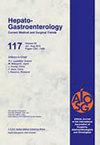Correlation of computed tomography imaging features and pathological features of 41 patients with pancreatic neuroendocrine tumors.
引用次数: 9
Abstract
BACKGROUND/AIMS Pancreatic neuroendocrine tumors (PNET) are relatively rare. Here, we present clinical and pathological characteristics of PNETs to show a relationship between computed tomography (CT) imaging and the 2010 World Health Organization (WHO) classification. METHODOLOGY We retrospectively reviewed the records of 41 PNET patients who were treated between 2002 and 2012. All tumors were classified as neuroendocrine tumor (NET) grade 1 (G1), NET grade 2 (G2), or neuroendocrine carcinoma (NEC) grade 3 (G3) on the basis of the 2010 WHO classification system. RESULTS Twenty-five tumors were classified as G1, 11 as G2, and five as G3. Mean sizes of the G1, G2 and G3 tumors were 1.84 ± 0.54, 4.90 ± 0.84, and 5.62 ± 1.18 cm, respectively, (P < 0.01). A PNET is typically hypervascular and exhibits contrast enhancement on enhanced CT. Higher percentage of G1 tumors demonstrated typical imaging and showed a significantly greater distinct mass compared with G2 and G3 tumors. CONCLUSIONS Although PNET has many imaging features that appear on CT, G2 and G3 tumors often show atypical imaging features, particularly with large sizes and/or ill-defined features, when compared with G1 tumors. If a PNET has atypical imaging features, possibility of malignancy should be considered.41例胰腺神经内分泌肿瘤的ct影像特征与病理特征的相关性分析。
背景/目的胰腺神经内分泌肿瘤(PNET)相对罕见。在这里,我们介绍PNETs的临床和病理特征,以显示计算机断层扫描(CT)成像与2010年世界卫生组织(WHO)分类之间的关系。方法回顾性分析2002 - 2012年间41例PNET患者的治疗记录。所有肿瘤均根据2010年WHO分类系统分为神经内分泌肿瘤(NET) 1级(G1)、NET 2级(G2)或神经内分泌癌(NEC) 3级(G3)。结果G1组25例,G2组11例,G3组5例。G1、G2、G3肿瘤的平均大小分别为1.84±0.54、4.90±0.84、5.62±1.18 cm,差异有统计学意义(P < 0.01)。PNET表现为典型的血管增生,增强CT上增强。与G2和G3肿瘤相比,G1肿瘤表现出典型的影像,明显的肿块比例较高。结论PNET具有许多CT表现的影像学特征,但与G1肿瘤相比,G2和G3肿瘤常表现出非典型的影像学特征,尤其是体积较大和/或特征不明确。如果PNET具有非典型的影像学特征,则应考虑恶性肿瘤的可能性。
本文章由计算机程序翻译,如有差异,请以英文原文为准。
求助全文
约1分钟内获得全文
求助全文
来源期刊

Hepato-gastroenterology
医学-外科
自引率
0.00%
发文量
1
审稿时长
1.9 months
期刊介绍:
Hepato-Gastroenterology has been discontinued as of 2015. Extremely limited quantities of back issues in print available for sale.
 求助内容:
求助内容: 应助结果提醒方式:
应助结果提醒方式:


